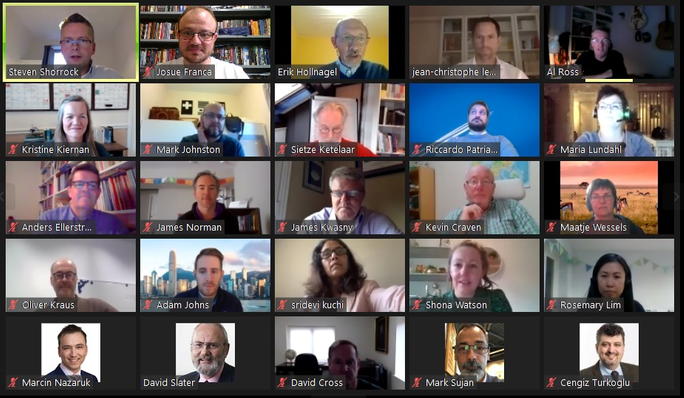(c) Erik Hollnagel, 2021
3rd International Workshop on Safety-II in Practice
Edinburgh via Zoom, October 13-15, 2020
Registered participants
Edwin Bailey - Christopher Watcham - Cengiz Turkoglu - Kevin Craven - Sridevi Kuchi
Chris Lea - James Norman - Tom Laursen - Mark Johnston - Duncan McNab
Paul Bowie - Maatje Wessels - Norman MacLeod - Sietze Ketelaar - Alex Wilbrink
Aart Ketelaar - Jane Carmody - Anders Ellerstrand - Riana Steen - Maria Lundahl
Melanie Ottewill - Peter Malady - Pedro Ferreira - Shona Watson - Johan Lowette
David Kershaw - James Kwasny - Guy Mouton - Mark Sujan - Riccardo Patriarca
Adam Johns - Franziska Homann - Oliver Kraus - Neil Spenceley - Deinniol Owens
Jacqueline Carr - Kristine Kiernan - John Hutchins - Anouk Vermeulen - Audrey Rost-Ernst
Alistair Ross - Josue Franca - David Cross - Rosemary Lim - Mais Iflaifel
Since the workshop took place via zoom, it was not possible to take the usual group picture. Instead a screenshot - taken just before the workshop closed - will have to suffice. Unfortunately it does not include everyone.
Monday October 12, 2020 | ||
14:00 - 15:15 | Erik Hollnagel | |
15:15 - 15:30 | Q&A | |
15:30 - 15:45 | Break | |
15:45 - 17:00 | Erik Hollnagel | |
17:00 - 17:15 | Q&A | |
Tuesday October 13, 2020 | ||
13:50 – 14:00 | Welcome & workshop logistics | Erik Hollnagel & David Slater |
Theme I: Safety-II at the micro level | ||
14:00 – 14:20 | Deinniol Owens | |
14:20 - 14:40 | Maria Lundahl | |
14:40 – 15:00 | Q & A | |
15:00 – 15:45 | Topical workshop – How can be represent safety in the models we use? | Mark Sujan |
15:45 – 16:00 | Short break | |
16:00 – 16:45 | Topical workshop - From observations to conversations | Pedro Ferreira |
16:45 – 17:00 | Open discussion | |
Wednesday October 14: Theme II: Safety-II at the meso level | ||
14:00 – 14:20 | Jess Wadsworth, Sabrina Vitello and David Slater | |
14:20 – 14:40 | Josue Franca | |
14:40 – 15:00 | Q&A | |
15:00 – 15:45 | Topical workshop – Education and training for Safety-II. | John Hutchins |
15:45 – 16:00 | Short break | |
16:00 – 16:45 | Marcin Nazaruk | |
16:45 – 17:00 | Open discussion | |
Thursday October 15: Theme III: Safety-II at the macro level | ||
14:00 – 14:20 | Adam Johns | |
14:20 - 14:40 | James Kwasny | |
14:40 – 15:00 | Kristy Kiernan | |
15:00 – 15:15 | Q&A | |
15:15 – 16:00 | Jean-Christophe Le Coze | |
16:00 – 16:15 | Short break | |
16:15 – 17:00 | Steve Shorrock | |
17:00 – 17:15 | Final discussion: What should happen next? | All |
